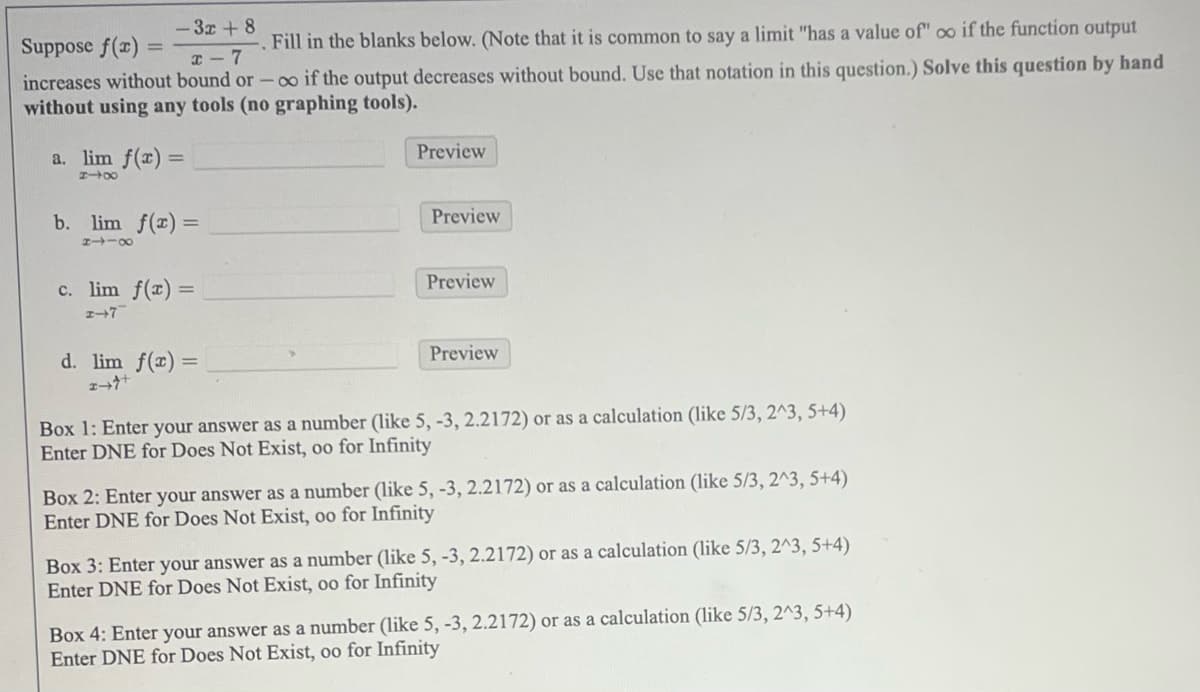-3x+8 x-7 Fill in the blanks below. (Note that it is common to say a limit "has a value of" oo if the function output increases without bound or -oo if the output decreases without bound. Use that notation in this question.) Solve this question by hand without using any tools (no graphing tools). Suppose f(x)= = a. lim f(x) = 818 b. lim f(x) = H118 c. lim f(x): Preview Preview Preview
-3x+8 x-7 Fill in the blanks below. (Note that it is common to say a limit "has a value of" oo if the function output increases without bound or -oo if the output decreases without bound. Use that notation in this question.) Solve this question by hand without using any tools (no graphing tools). Suppose f(x)= = a. lim f(x) = 818 b. lim f(x) = H118 c. lim f(x): Preview Preview Preview
Calculus: Early Transcendentals
8th Edition
ISBN:9781285741550
Author:James Stewart
Publisher:James Stewart
Chapter1: Functions And Models
Section: Chapter Questions
Problem 1RCC: (a) What is a function? What are its domain and range? (b) What is the graph of a function? (c) How...
Related questions
Question
5)Suppose ….. Fill in the blanks below. (Note that it is common to say a limit "has a value of" o if the function output increases without bound or - ∞ if the output decreases without bound. Use that notation in this question.) Solve this question by hand without using any tools (no graphing tools).

Transcribed Image Text:-3x+8
Suppose f(x)=
=
x-7
Fill in the blanks below. (Note that it is common to say a limit "has a value of" oo if the function output
increases without bound or -∞o if the output decreases without bound. Use that notation in this question.) Solve this question by hand
without using any tools (no graphing tools).
a. lim f(x) =
818
b. lim f(x) =
8118
c. lim f(x) =
2-7
d. lim f(x) =
I+
Preview
Preview
Preview
Preview
Box 1: Enter your answer as a number (like 5, -3, 2.2172) or as a calculation (like 5/3, 2^3, 5+4)
Enter DNE for Does Not Exist, oo for Infinity
Box 2: Enter your answer as a number (like 5, -3, 2.2172) or as a calculation (like 5/3, 2^3, 5+4)
Enter DNE for Does Not Exist, oo for Infinity
Box 3: Enter your answer as a number (like 5, -3, 2.2172) or as a calculation (like 5/3, 2^3, 5+4)
Enter DNE for Does Not Exist, oo for Infinity
Box 4: Enter your answer as a number (like 5, -3, 2.2172) or as a calculation (like 5/3, 2^3, 5+4)
Enter DNE for Does Not Exist, oo for Infinity
Expert Solution
This question has been solved!
Explore an expertly crafted, step-by-step solution for a thorough understanding of key concepts.
This is a popular solution!
Trending now
This is a popular solution!
Step by step
Solved in 4 steps with 4 images

Recommended textbooks for you

Calculus: Early Transcendentals
Calculus
ISBN:
9781285741550
Author:
James Stewart
Publisher:
Cengage Learning

Thomas' Calculus (14th Edition)
Calculus
ISBN:
9780134438986
Author:
Joel R. Hass, Christopher E. Heil, Maurice D. Weir
Publisher:
PEARSON

Calculus: Early Transcendentals (3rd Edition)
Calculus
ISBN:
9780134763644
Author:
William L. Briggs, Lyle Cochran, Bernard Gillett, Eric Schulz
Publisher:
PEARSON

Calculus: Early Transcendentals
Calculus
ISBN:
9781285741550
Author:
James Stewart
Publisher:
Cengage Learning

Thomas' Calculus (14th Edition)
Calculus
ISBN:
9780134438986
Author:
Joel R. Hass, Christopher E. Heil, Maurice D. Weir
Publisher:
PEARSON

Calculus: Early Transcendentals (3rd Edition)
Calculus
ISBN:
9780134763644
Author:
William L. Briggs, Lyle Cochran, Bernard Gillett, Eric Schulz
Publisher:
PEARSON

Calculus: Early Transcendentals
Calculus
ISBN:
9781319050740
Author:
Jon Rogawski, Colin Adams, Robert Franzosa
Publisher:
W. H. Freeman


Calculus: Early Transcendental Functions
Calculus
ISBN:
9781337552516
Author:
Ron Larson, Bruce H. Edwards
Publisher:
Cengage Learning